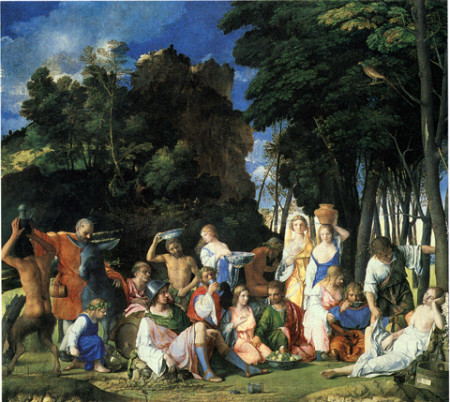When Alfonso d’Este, the Duke of Ferrara, and his wife Lucrezia Borgia, asked for a painting expressing worldly delights, drinking, and sensuality, Giovanni Bellini could not refuse the offer though he was eighty-five and in failing health.
The Feast of the Gods [Il festino degli dei] is one of Ovid’s many Priapic jokes. (1514). It’s a lewd story of how Priapus tried but failed to rape a sleeping nymph, who awakened when Silenus’ donkey brayed. Bellini smoothed out Ovid’s lechery and “amorous fires” so that much of the ribaldry is subtle and requires careful searching. Whether or not Ovid would have enjoyed Bellini’s restraint seems doubtful.
Ovid liked the story of Priapus and the donkey well enough to tell it twice in Fasti, a monthly Roman calendar annotated with tales of gods, goddesses, and other deities, and again in Metamorphosis. His details vary, and the guest list changes, but the story and punch line in Fasti 1 (January) and Fasti 6 (June) is always the same: Priapus is foiled when the donkey brays. In Metamorphosis, however, the emphasis shifts to Lotis, the nymph, while frantically seeking to escape Priapus is transformed into the flower that bears her name.
Bellini borrowed freely from Ovid and perhaps Giovanni di Bonsignore’s contemporary illustrated translation of Metamorphosis [Ovidio Metamorphoses Volgare (1497). Among Bonsignore’s woodcuts are crude and emphasize debauchery. Unidentified guests are left, particularly a man lifting a woman’s dress to reveal her pubic hair. In the center, Selinus’ donkey, tethered to a tree, has already brayed and stands contrite. Lotis, however, is in full flight, chased by Priapis, who has an obvious erection under his jerkin.
Though Ovid calls the party a convocat, it is usually translated as feast or banquet. Bellini calls it a feast, festin but presents it as merenda, used by Italians as a euphemism for a picnic suggesting a light afternoon meal or snack in an alfresco setting but here a bacchanal, drinking party. Ovid doesn’t mention food, but Bellini provides serving plums, peaches, grapes, and quince, all of which have discreet symbolic sexual connotations rather than showing the real thing. What we see is relatively desexualized; Priapus’ erection is hidden, though nymph Lotis’ breasts are exposed. In the front row, the prominent guests of honor sit comfortably, dressed in rustic garb suitable to the informality of a picnic in the woods. Bellini’s original version left the identities of the gods ambiguous, and subsequent revisions by other artists, Dosso Dossi and Titian, significantly added details identifying each guest.)
Bellini’s figures in the landscape are static. This arrangement is his preferred structural element, a still life in which the bemused (drunken) gods, goddesses, nymphs, and satyrs are still, posing as if for a group portrait. Priapis has his hand on Lotis’ dress and is about to remove it; the donkey is silent—but not yet. A moment, “raucous braying” will jolt them all from their drowsy reverie. The perfect moment just before the tumult destroys repose.
See Ovid. Fasti. Translated by James George Frazer. Cambridge, MA & London: Loeb Classical Library, Harvard University Press and William Heinemann Ltd., 1931; Thomas J. Sienkewicz. Classical Gods and Heroes in the National Gallery of Art by (Washington, D.C.: University Press of America, 1983); David O. Franz. Festum Voluptatis: A Study of Renaissance Erotica (Columbus: Ohio State University Press, 1989); Adrienne von Lates. “Caravaggio’s Peaches and Academic Puns.” Word and Image 11, 1 (1995); Carolin A. Young. Golden Apples in Settings of Silver (New York, 2003.); Rona Goffen, Giovanni Bellini. New Haven: Yale University Press, 1989
* The National Gallery of Art, Washington, D.C., identifies the picnickers as follows:
Silenus, a woodland god attended by his donkey
Bacchus, the infant god of wine crowned with grape leaves
Silvanus, an old forest god wearing a wreath of pine needles
Mercury, the messenger of the gods carrying his caduceus or herald’s staff
Jupiter, the king of the gods accompanied by an eagle
Persephone, holding a quince, a fruit associated in the ancient world with marriage
Pan, a satyr with a grape wreath who blows on his shepherd’s pipes
Neptune, the god of the sea, sitting beside his trident harpoon
Ceres, the goddess of cereal grains with a wreath of wheat
Apollo, god of the sun and the arts, crowned by laurel and holding a Renaissance stringed musical instrument, the lira da braccio, instead of a classical lyre
Priapus, the god of virility and vineyards with a scythe, used to prune orchards, hanging from the tree above him
Lotis, one of the naiads, is a nymph of freshwater who represents chastity.

